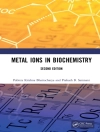The desire to quantify the presence of analytes within diverse physiological, environmental and industrial systems has led to the development of many novel detection methods. In this arena, saccharide analysis has exploited the pair-wise interaction between boronic acids and saccharides. Boronic Acids in Saccharide Recognition provides a comprehensive review and critical analysis of the current developments in this field. It also assesses the potential of this innovative approach, outlining future lines of research and possible applications. Topics include: the molecular recognition of saccharides, the complexation of boronic acids with saccharides, fluorescent sensors and the modular construct of fluorescent sensors, further sensory systems for saccharide recognition and an extensive bibliography. This high level book is ideal for researchers both academic and industrial who require a comprehensive overview of the subject.
विषयसूची
1: Introduction;
2: The Molecular Recognition of Saccharides;
2.1: Molecular Recognition;
2.2: The Importance of Saccharides;
2.3: Non-Boronic Acid Appended Synthetic Sensors for Saccharides;
3: Complexation of Boronic Acids with Saccharides;
3.1: A Brief History;
3.2: Acidity and the O-B-O Bond Angle;
3.3: Complex Formation and Dependence on p H;
3.4: Binding Constants and the Influence of Lewis Bases;
4: Fluorescent Sensors;
4.1: The Application of Fluorescence in Sensing;
4.2: Photoexcitation and Subsequent Relaxation;
4.3: Excited State Internal Charge Transfer (ICT);
4.4: Fluorescent Internal Charge Transfer (ICT) Sensory Systems;
4.5: Excited State Photoinduced Electron Transfer (PET);
4.6: Photoinduced Electron Transfer (PET) Sensory Systems;
4.7: Ditopic Sensors;
4.8: Other Fluorescent Sensors;
4.9: Amine – Boron (N-B) Interactions;
4.10: The Importance of Pyranose to Furanose Interconversion;
4.11: Summary;
5: Modular Fluorescent Sensors;
5.1: The Design Rationale;
5.2: Modular Systems;
5.3: Energy Transfer Systems;
5.4: Fluorophore Dependence in Modular Systems;
5.5: Other approaches;
5.6: Summary;
6: Other types of sensor;
6.1: Colorimetric sensors;
6.2: Electrochemical Sensors;
6.3: Assay Systems;
6.4: Polymer and Surface Bound Sensors;
6.5: Odds and Ends;
7: OTHER SYSTEMS FOR SACCHARIDE RECOGNITION;
7.1: Receptors at the Air-Water Interface;
7.2: Transport and Extraction;
7.3: CD Receptors;
7.4: Molecular Imprinting;
8: Conclusions;
9: Bibliography












